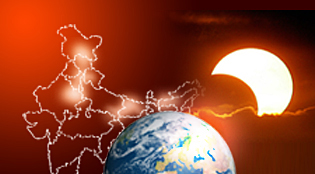Solar Eclipse - When, Why and How it Occurs
 Except for India, in other countries, Solar Eclipse, has more of
scientific importance than spiritual. For scientist, it is not less then a big festival.
On this day, scientist get new opportunities for research work. At times, they wait
long for this day, as, Solar Eclipse is very useful in understanding the universe.
Except for India, in other countries, Solar Eclipse, has more of
scientific importance than spiritual. For scientist, it is not less then a big festival.
On this day, scientist get new opportunities for research work. At times, they wait
long for this day, as, Solar Eclipse is very useful in understanding the universe.
At this time scientist get many new facts for research. Today, scientist try bringing up new information about the rays coming out of Sun, by studying them.
What is a Solar Eclipse?
When a celestial body covers the other body fully or partially, it’s called an Eclipse. In this, celestial body gets interrupted and dose not appear. Sun is a heavily body around which planets circulate. While moving in an orbit when three celestial bodies come in same line, Eclipse is formed.
Solar Eclipse occur when Sun gets partially or fully covered by Moon. For this kind of Eclipse formation, it is required by Moon to come in between of Earth and Sun. This way people living on Earth can not see the covered part of Sun.
Solar Eclipse According to Vedic Jyotish
Conditions for Solar Eclipse:
- Should be full Moon or no Moon
- Moon’s longitude should have Rahu and Ketu.
- Latitude of Moon should be near zero.
Understanding Longitude and Latitude For Solar Eclipse
Lines running from North Pole to South Pole are called Longitudes. And, the lines going along equator are called the Latitudes.
Solar Eclipse always occur on a no moon day. When Moon is weakest and Sun has full capacity and self-lightning. The longitude of Moon and Rahu or Ketu should be very close. Latitude of Moon should be near about zero. And, this is possible when Moon is at or near Ravimarg. On Solar Eclipse the angular diameters of Sun and Moon are same. That is why, Moon can cover sun only for a short period of time.
The area which is covered at the time of Solar Eclipse is called full shade area. The speed of Moon’s shadow increases from 1800 km to 8000 km per hour. But, it depends on the positioning of Moon. This is the reason why Solar Eclipse doesn't stay for more then seven and a half minute at a place.
Three Types of Solar Eclipse
1. Full Solar Eclipse
Full Solar Eclipse occurs when Moon takes Earth in it’s full shadow zone. As a result the Sun rays are not able to reach the Earth. And, a state of darkness is created on Earth. This kind of Eclipse formed is called Solar Eclipse.
2. Partial Solar Eclipse
In case of Partial Solar Eclipse, Moon takes only some part of Sun in it’s shadow area. This way, some part of Sun is in the area of Eclipse where as, the other part is not effected. This is called Partial Solar Eclipse.
3. Elliptical Solar Eclipse
The third and last type of Solar Eclipse is called the elliptical Solar Eclipse. In this case, Moon covers the Sun in such a form that only the middle portion of Sun is under the shadow zone of Moon. The outer region of Sun is illumined, giving it a look of a bracelet. This bracelet shaped Solar Eclipse is called the elliptical Solar Eclipse.
When will the next Solar Eclipse occur
After a long research it has come out that, every year the count of Solar Eclipse will get decreased. Solar Eclipse is a naturally occurring unique incident. In 100 years it is expected that this kind of more than 200 Solar Eclipse are to occur. It is not necessary that all these Solar Eclipse would be visible in India. Possibly only a few could be seen here. Every year the number of Solar Eclipse mentioned are assumed to occur as per the minimum approximation count.
Eclipse in 2024
- 01th May 2024 - Khandagras Solar Eclipse
- 25th October 2024 - Khandagras Solar Eclipse


